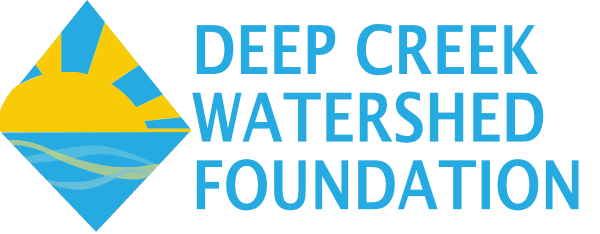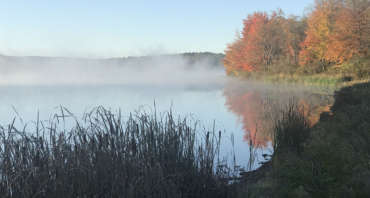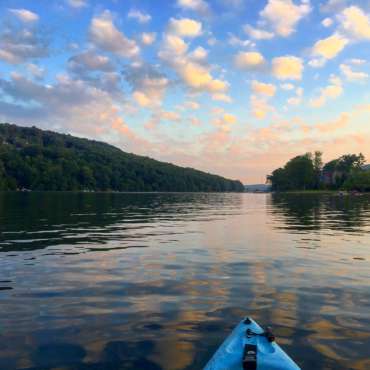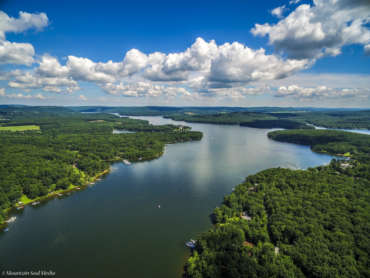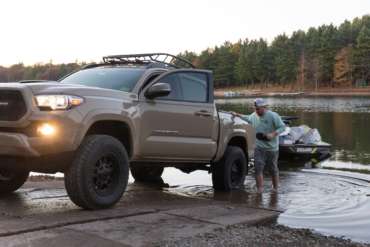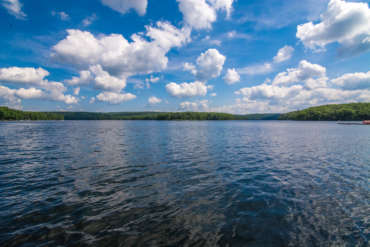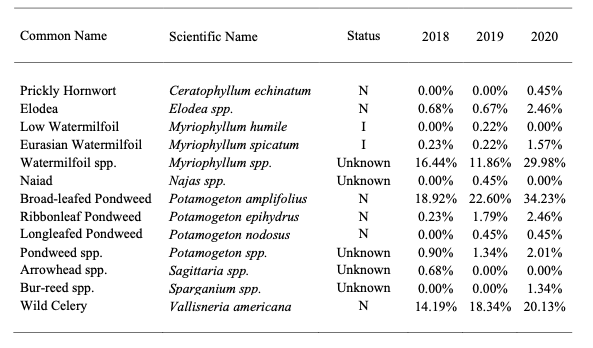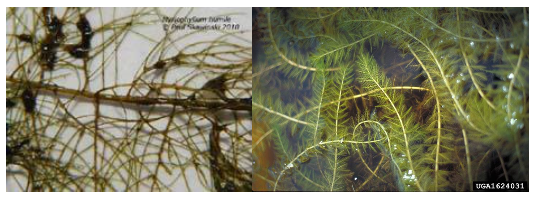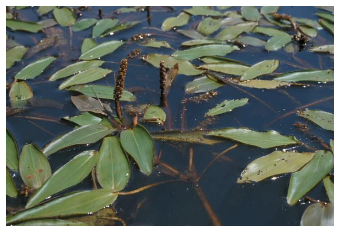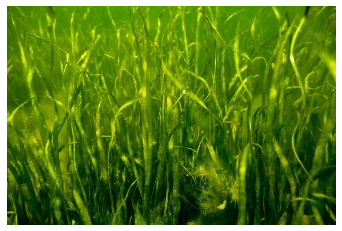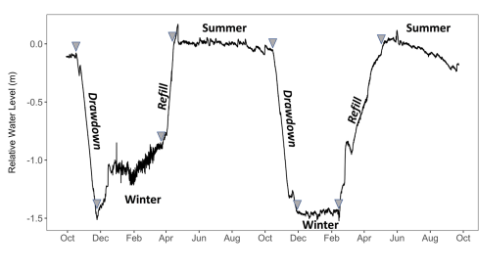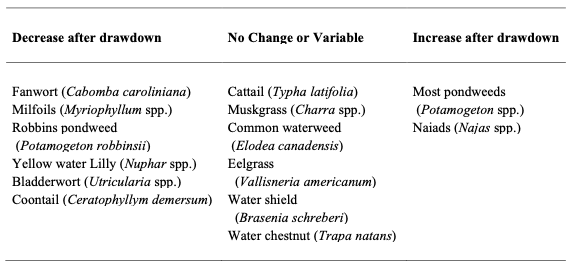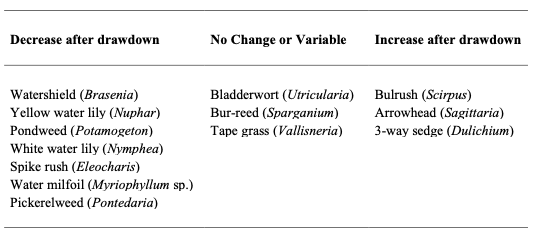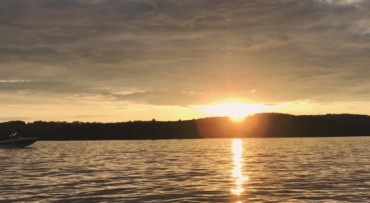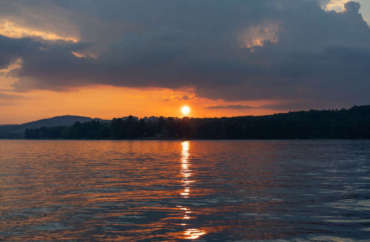The proposed dredging of Arrowhead Run Cove may prove instructive to assess the physical changes associated with drawdowns and the mechanical removal of both plants and silt. This could serve as a model of sorts to determine what other data should be assessed to determine the efficacy of such an action at Deep Creek Lake and what the implications may be.
Literature Cited
Aiken, S. G., P. R. Newroth, and I. Wile. 1979. The biology of Canadian weeds. Myriophyllum spicatum L. Canadian Journal of Plant Science 59: 201-215.
Allen, A.W. and R.D. Hoffman. 1984. Habitat Suitability Index Models: Muskrat. U.S. Fish and Wildlife Service, FWS ⁄ OBS82 ⁄ 10.46. 27 pp.
Aroviita, J. and H. Hämäläinen. 2008. The impact of water-level regulation on littoral macroinvertebrate assemblages in boreal lakes. Hydrobiologia 613:45-56.
Arthaud, F., D. Vallod, J. Robin, and G. Bornette. 2012. Eutrophication and drought disturbance shape functional diversity and life history traits of aquatic plants in shallow lakes. Aquatic Science 74:471- 481.
Avakyan, A.B. and S.A. Podol’skii. 2002. Impact of Reservoirs on the Fauna. Water Resources 29(2):123-132.
Beklioglu, M., G. Altinayar, and C.O. Tan. 2006. Water level control over submerged macrophyte development in five shallow lakes of Mediterranean Turkey. Archiv für Hydrobiologie 166:535-556.
Bettoli, P.W., M.J. Maceina, R.L. Noble, and R.K. Betsill. 1993. Response of a reservoir fish community to aquatic vegetation removal. North American Journal of Fisheries Management 13:110-124.
Bodaly, R.A. and L.F.W. Lesack. 1984. Response of a Boreal Northern Pike (Esox lucius) Population to Lake Impoundment: Wupaw Bay, Southern Indian Lake, Manitoba. Canadian Technical Report of Fisheries and Aquatic Sciences 41:706-714.
Bornette G. and S. Puijalon. 2011. Response of aquatic plants to abiotic factors: a review. Aquatic Science 73:1-14.
Boschilia S.M., E.F. De Oliveira, and A. Schwarzbold. 2012. The immediate and long-term effects of water drawdown on macrophyte assemblages in a large subtropical reservoir. Freshwater Biology 57:2641-2651.
Carmignani, J.R. and A.H. Roy. 2017. Ecological impacts of winter water level drawdowns on lake littoral zones: a review. Aquatic Sciences 79:803-824.
Colle, D.E. and J.V. Shireman. 1980. Coefficients of condition for largemouth bass, bluegill, and redear sunfish in Hydrilla-infested lakes. Transactions of the American Fisheries Society 109:521-531.
Cooke, G.D. 1980. Lake level drawdown as a macrophyte control technique. Journal of the American Water Resources Association 16:317-322.
Cooke, G.D., E.B Welch, S.A Peterson, and S.A. Nichols. 2005. Restoration and management of lakes and reservoirs, 3rd ed. CRC Press Boca Raton, Florida.
Cott, P.A., P.K. Sibley, A.M. Gordon, R.A. Bodaly, K.H. Mills, W.M. Somers, and G.A. Fillatre. 2008. The Effects of Water Withdrawal from Ice-Covered Lakes on Oxygen, Temperature and Fish. Journal of the American Water Resources Association 41:328-342.
Cross, T.K., M.C. McInerny, and R.A. Davis. 1992. Macrophyte removal to enhance bluegill, largemouth bass, and northern pike populations. Minnesota Department of Natural Resources, Section of Fisheries Investigational Report 415, St. Paul, Minnesota.
Dannel, K. 1978. Intra- and Interannual Changes in Habitat Selection by the Muskrat. Journal of Wildlife Management 42(3):540- 549.
Cooley, P.M. and W.G. Franzin. 2008. Predicting the spatial mud energy and mud deposition boundary depth in a small boreal reservoir before and after draw down. Lake and Reservoir Management 24: 261-272.
Craig, V.E. 1952. A story of fish production as it applies to Montana. M.S. Thesis. Montana State University, Bozeman, Montana.
Dvorak, J. and E.P. Best. 1982. Macro-invertebrate communities associated with the macrophytes of Lake Vechten: structural and functional relationships. Hydrobiologia 95:115-126.
Effler, S.W. and D.A. Matthews. 2004. Sediment resuspension and drawdown in a water supply reservoir. Journal of the American Water Resources Association 40: 251-264.
Eiswerth, M.E., S.G. Donaldson, and W.S. Johnson. 2000. Potential environmental impacts and economic damages of Eurasian watermilfoil (Myriophyllum spicatum) in western Nevada and
northeastern California. Weed Technology 14(3):511-518.
Fox J., P.L. Brezonick, and M.A Keirn. 1977. Lake drawdown as a method for improving water quality. U.S. Environmental Protection Agency, Corvallis Environmental Research Laboratory, Corvallis, Oregon.
Fredrickson, L.H. 1991. Strategies for water level manipulation in moist-soil systems. U.S. Fish and Wildlife Service. Leaflet 13.4.6. 8 pp.
Furey, P.C., R.N. Nordin, and A. Mazumder. 2004. Water level drawdown affects physical and biogeochemical properties of littoral sediments of a reservoir and a natural lake. Lake and Reservoir Management 20: 280-295.
Furey, P.C., R.N. Nordin, and A. Mazumder. 2006. Littoral Benthic Macroinvertebrates Under Contrasting Drawdown in a Reservoir and a Natural Lake. Journal of the North American Benthological Society 25(1):19-31.
Gaboury, M.N. and J.W. Patalas. 1984. Influence of Water Level Drawdown on the Fish Populations of Cross Lake, Manitoba. Canadian Journal of Fisheries and Aquatic Sciences 41:118-125.
Glass, B.P. 1952. Factors Affecting the Survival of the Plains Muskrat Ondatra Zibethica Cinnamomina in Oklahoma. Journal of Wildlife Management 16:484-491.
Grime, J. 1977. Evidence for the existence of three primary strategies in plants and its relevance to ecological and evolutionary theory. American Naturalist 111:1169-1194.
Groen, C.L. and T.A. Schroeder. 1978. Effects of water level management on walleye and other coolwater fishes in Kansas reservoirs. American Fisheries Society Special Publication 11:278–283.
Hellsten, S.K. 1997. Environmental factors related to water level regulation-a comparative study in northern Finland. Boreal Environmental Research 2:345-367.
Hellsten, S.K. 2000. Environmental factors and aquatic macrophytes in the littoral zone of regulated lakes: causes, consequences and possibilities to alleviate harmful effects. Thesis, University of Oulu, Oulu, Finland.
Howard R.J. and C.J. Wells. 2009. Plant community establishment following drawdown of a reservoir in southern Arkansas, USA. Wetlands Ecological Management 17:565-583.
Hudon, C. 2004. Shift in Wetland Plant Composition and Biomass Following Low-Level Episodes in the St. Lawrence River Aquatic Vegetation: Looking Into the Future. Canadian Journal of Fisheries and Aquatic Sciences 61:603-617.
Hulsey, A.H. 1957. Effects of a fall and winter drawdown on a flood control lake. In: Proceedings of the annual conference southeastern association of game and fish commissioners 10:285-289.
James, W.F., J.W. Barko, H.L. Eakin, and D.R. Helsen. 2001. Changes in sediment characteristics following drawdown of Big Muskego Lake, Wisconsin. Archiv Fur Hydrobiologie 151:459-474.
Järvalt, A. and E. Pihu. 2002. Influence of Water Level on Fish Stocks and Catches in Lake Võrtsjärv. Proceedings of the Estonian Academy of Sciences. Biology and Ecology 51:74-84.
Johnsgard, P.A. 1956. Effects of water fluctuation and vegetation change on bird populations, particularly waterfowl. Ecology 37: 689-701.
Johnstone, I.M., B.T. Coffey, and C. Howard-Williams. 1985. The role of recreational boat traffic in interlake dispersal of macrophytes: a New Zealand case study. Journal of Environmental Management 20:263-279.
Keddy, P.A. and A.A. Reznicek. 1986. Great Lakes vegetation dynamics: the role of fluctuating water levels and buried seeds. Journal of Great Lakes Research 12:25-36.
Keto, A., A. Tarvainen, and S. Hellsten. 2006. The effect of water level regulation on species richness and abundance of aquatic macrophytes in Finnish lakes. Verhandlungen des Internationalen Verein Limnologie 29:2103-2108.
Klotz, R.L. and S.A. Linn. 2001. Influence of factors associated with water level drawdown on phosphorus release from sediments. Lake and Reservoir Management 17:48-54.
Korschgen, C.E. and W.L. Green. 1988. American wild celery (Vallisneria americana): ecological considerations for restoration (No. 19). US Department of the Interior, Fish and Wildlife Service.
Lantz, K.E., J.T. Davis, J.S. Hughes, and H.E. Schafer Jr. 1967. Water level fluctuation-its effects on vegetation control and fish population management. In: Proceedings of the Annual Conference Southeastern Association of Game and Fish Commissioners 18:483-494.
Madsen, J.D., L.W. Eichler, and C.W. Boylen. 1988. Vegetative spread of Eurasian watermilfoil in Lake George, New York. Journal of Aquatic Plant Management 26:47-50.
McEwen, D.C. and M.G. Butler. 2010. The effects of water-level manipulation on the benthic invertebrates of a managed reservoir. Freshwater Biology 55:1086-1101.
McGowan, S., P.R. Leavitt, and R.I. Hall. 2005. A Whole-Lake Experiment to Determine the Effects of Winter Drought on Shallow Lakes. Ecosystems 8(6):694-708.
Minnesota DNR (MN DNR). 2022. Wild celery (Vallisneria americana). .
Mississippi Interstate Cooperative Resource Association (MICRA). 2015. The use of grass carp in the United States. A report to the US Fish and Wildlife Service – Agreement #F12AP00630. .
Mjelde, M., S. Hellsten, and F. Ecke. 2012. A water level drawdown index for aquatic macrophytes in Nordic lakes. Hydrobiologia 704:141-151.
Murkin, H. R., R. M. Kaminski, and R. D. Titman. 1982. Responses of dabbling ducks and aquatic invertebrates to an experimentally manipulated cattail marsh. Canadian Journal of Zoology 60: 2324-2332.
Nelson, T. and M. Bowyer. 2000. Managing wetland vegetation for marshbirds and waterfowl. Final project report: FY00 Wildlife Preservation Fund, Eastern Illinois University, Charleston, Illinois.
New York State DEC (NYSDEC). 2005. A primer on aquatic plant management in New York State. NYSDEC Division of Water. Draft Report.
Nichols, S.A. and B.H. Shaw. 1986. Ecological life histories of the three aquatic nuisance plants, Myriophyllum spicatum, Potamogeton crispus, and Elodea canadensis. Hydrobiologia 131:3-21.
Paller, M.H. 2011. Recovery of a reservoir fish community from drawdown related impacts. North American Journal of Fisheries Management 17:726-733.
Perry, R. 1982. Muskrats. In: Wild Mammals of North America, J. Chapman and G. Feldhamer (Editors). John Hopkins University Press, Baltimore, Maryland, 1147 pp.
Radomski, P.J., T.J. Goeman, and P.D. Spencer. 1995. The effects of chemical control of submerged vegetation on the fish community of a small Minnesota centrarchid lake. Minnesota Department of Natural Resources, Section of Fisheries Investigational Report 442, St. Paul, Minnesota.
Reznicek, A.A., E.G. Voss, and B.S. Walters. 2011. Michigan Flora Online. University of Michigan.
Rogers, K.B. and E.P. Bergersen. 1995. Effects of a Fall Drawdown on Movement of Adult Northern Pike and Largemouth Bass. North American Journal of Fisheries Management 15:596-600.
Rørslett, B. 1989. An integrated approach to hydropower impact assessment. II. Submerged macrophytes in some Norwegian hydro-electric lakes. Hydrobiologia 175:65-82.
Siver, P.A., A.M. Coleman, G.A. Benson, and J.T. Simpson. 1986. The effects of winter drawdown on macrophytes in Candlewood Lake, Connecticut. Lake Reservoir Management 2:69-73.
Slade, J.G. 2005. Evaluation of fish-habitat relationships following a species-specific herbicide treatment in Minnesota. M.S. thesis, Mississippi State University, Mississippi State.
Smith C.G. and J.W. Barko. 1990. Ecology of Eurasian watermilfoil. Journal of Aquatic Plant Management 28:55-64.
Sutela T., J. Aroviita, and A. Keto. 2013. Assessing ecological status of regulated lakes with littoral macrophyte, macroinvertebrate and fish assemblages. Ecological Indicators 24:185-192.
Tarver, D.P. 1980. Water fluctuation and the aquatic flora of Lake Miccosukee. Journal of Aquatic Plant Management 18:19-23.
Tazik, P.P., W.R. Kodrich, and J.R. Moore. 1982. Effect of overwinter drawdown on bushy pondweed. Journal of Aquatic Plant Management 20:19-21.
Texas A&M. 2022a. How to control eelgrass: A diagnosis tool for pond plants and algae. .
Texas A&M. 2022b. How to control large-leafed pondweed: A diagnosis tool for pond plants and algae. .
Thomaz, S.M., T.A. Pagioro, L.M. Bini, and K.J Murphy. 2006. Effect of reservoir drawdown on biomass of three species of aquatic macrophytes in a large sub-tropical reservoir (Itaipu, Brazil). Hydrobiologia 570:53-59.
Thorp, J.H. and A.P. Covich, 1991. Ecology and Classification of North American Freshwater Invertebrates. Academic Press, San Diego, California, 911 pp.
Tomcko, C.M. and D.L. Pereira. 2006. The relationship of bluegill population dynamics and submerged aquatic vegetation in Minnesota lakes. Minnesota Department of Natural Resources, Investigative Report 538.
Trottier, G., H. Embke, K. Turgeon, C. Solomon, C. Nozais, and I. Gregory-Eaves. 2019. Macroinvertebrate abundance is lower in temperate reservoirs with higher winter drawdown. Hydrobiologia 834:199-211.
Turner, M.A., D.B. Huebert, D.L. Findlay, L.L. Hendzel, W.A. Jansen, R.A. Bodaly, L.M. Armstrong, and S.E.M. Kasian. 2005. Divergent Impacts of Experimental Lake-Level Drawdown on Planktonic and Benthic Plant Communities in a Boreal Forest Lake. Canadian Journal of Fisheries and Aquatic Sciences 62:991-1003.
Twinch, A.J. 1987. Phosphate exchange characteristics of wet and dried sediments samples from a hypertrophic reservoir. Implications for the measurement of phosphorus states. Water Resources 21:1225-1230.
University of Florida IFAS Center for Aquatic and Invasive Plants. 2021. Sections 3. Control Methods. .
Verrill, D.D. and C.R. Berry Jr. 1995. Effectiveness of an electric barrier and lake drawdown for reducing common carp and bigmouth buffalo abundances. North American Journal of Fisheries Management 15:137-141.
Voss, E.G. and A.A. Reznicek. 2012. Field manual of Michigan flora. University of Michigan Press, Ann Arbor, Michigan.
Wagner, T. and C.M. Falter. 2002. Response of an aquatic macrophyte community to fluctuating water levels in an oligotrophic lake. Lake Reservoir Management 18:52-65.
Wakeman, R.W. and D.H. Les. 1994. Optimum growth conditions for Potamogeton amplifolius, Myriophyllum spicatum and Potamogeton richardsonii. Lake and Reservoir Management 9:129-133.
Washington Department of Fish and Wildlife (WDFW). 2015. Aquatic plants and fish: rules for aquatic plant removal and control. Washington Department of Fish and Wildlife.
Weller, M.W. 1978. Management of freshwater marshes for wildlife. p. 267-284. In R. E. Good, D. F.
Whigham, and R. L. Simpson (eds.) Freshwater Wetlands, Ecological Processes and Management Potential. Academic Press, New York, NY, USA.
Weller, M.W. 1981. freshwater Marshes. University of Minnesota Press, Minneapolis, MK USA.
Weller, M.W. and C.S. Spatcher. 1965. Role of habitat in the distribution and abundance of marsh birds. Iowa Agricultural and Home Economics Experiment Station. Ames, IA. Special Report No. 43.
Wetzel, R.G. 2001. Limnology: Lake and River Ecosystems. Gulf Professional Publishing, Houston.
White, M.S., M.A. Xenopoulos, K. Hogsden, R.A Metcalfe, and P.J. Dillon. 2008. Natural level fluctuation and associated concordance with water quality and aquatic communities within small lakes of the Laurentian Great Lakes region. Hydrobiologia 613:21-31.
White, M.S., M.A. Xenopoulos, R.A. Metcalfe, and K.M. Somers. 2010. On the role of natural water level fluctuation in structuring littoral benthic macroinvertebrate community composition in lakes. Limnology and Oceanography 55:2275-2284.
White, M.S., M.A. Xenopoulos, R.A. Metcalfe, and K.M. Somers. 2011. Water level thresholds of benthic macroinvertebrate richness, structure, and function of boreal lake stony littoral habitats. Canadian Journal of Fisheries and Aquatic Sciences 68:1695-1704.
Wichelen, J.V., S. Declerck, K. Muylaert, I. Hoste, V. Geenens, J. Vanderkerkhove, E. Michels, N. DePauw, M. Hoffmann, L. DeMeester, and W. Vyverman, 2007. The importance of drawdown and sediment removal for the restoration of the eutrophied shallow Lake Kraenepoel (Belgium) Hydrobiologia 584:291-303.
Wilcox, D.A. and J.E. Meeker. 1991. Disturbance effects on aquatic vegetation in regulated and unregulated lakes in northern Minnesota. Canadian Journal of Botany 69: 1542-1551.
